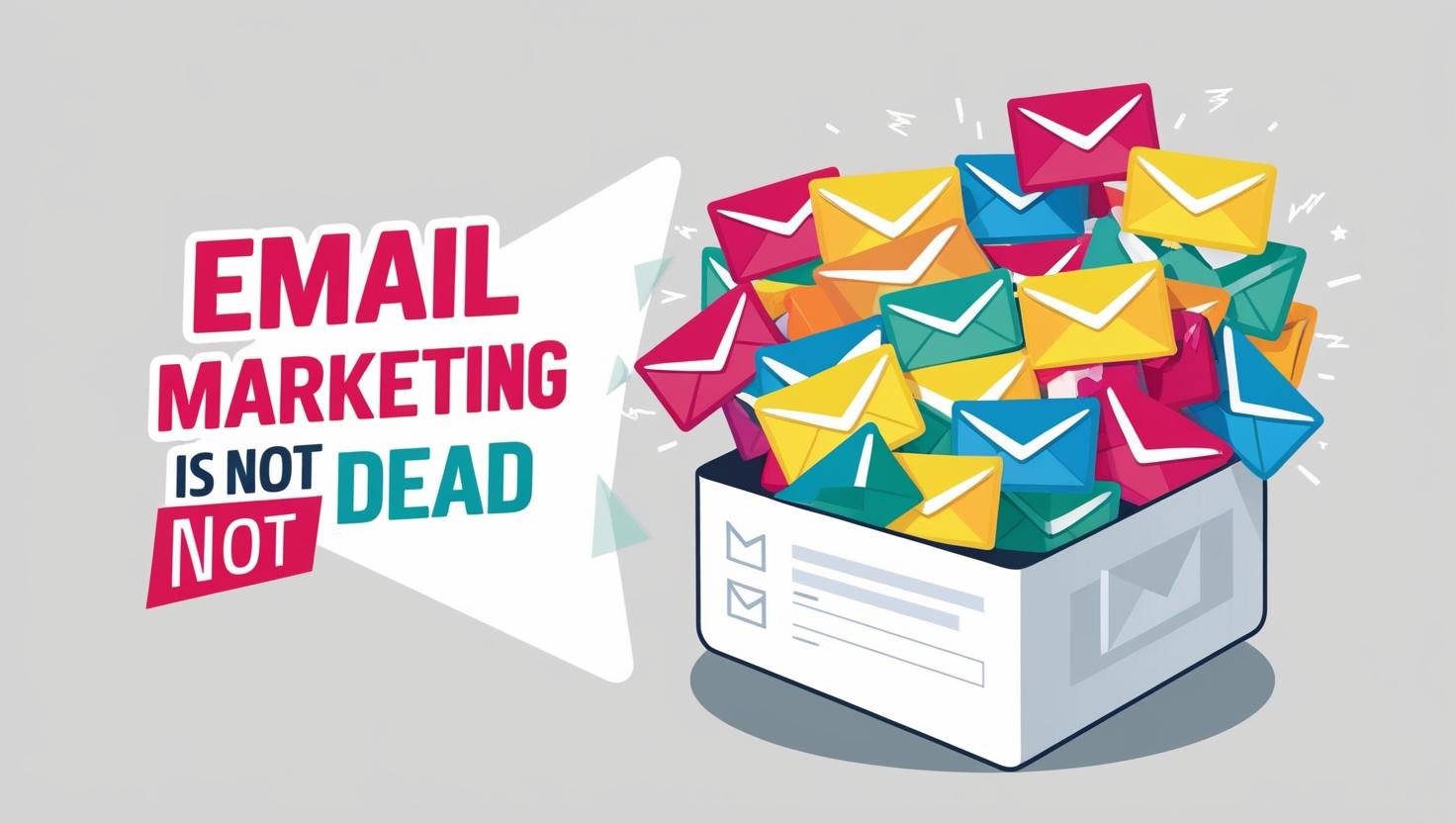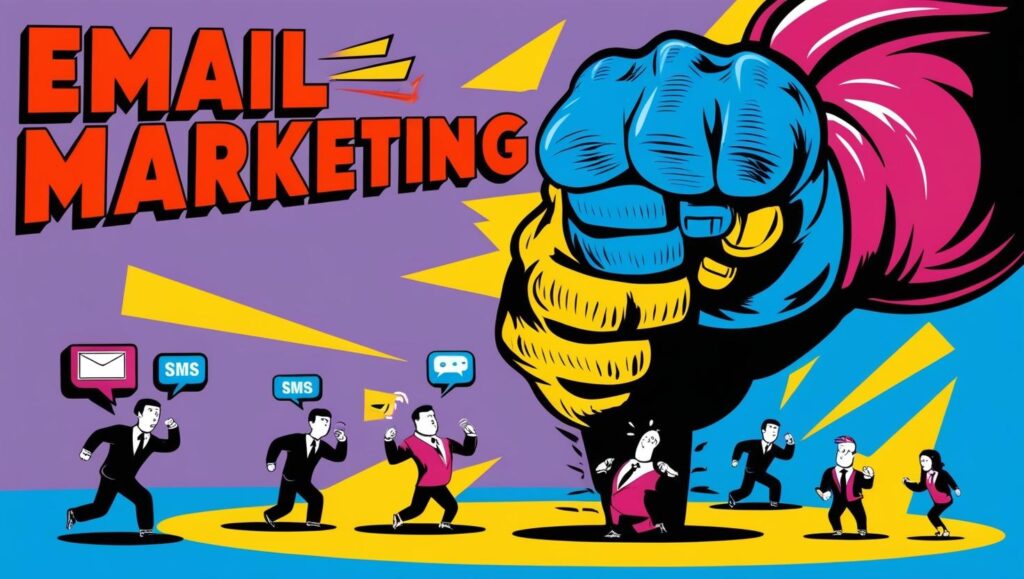Email Marketing Is NOT Dead: Here’s Why It’s Still the Best ROI for Your Business

In the ever-evolving world of digital marketing, a common refrain echoes year after year: “Email marketing is dead!” Yet, businesses across industries continue to rely on email campaigns to generate impressive returns on investment (ROI). If you’re among those wondering whether email marketing still holds value, rest assured—it’s not just alive; it’s thriving.
In this article, we’ll explore why email marketing remains one of the best marketing channels, debunk the myths surrounding its “death,” and share actionable tips to help you maximize your email ROI.
What Makes Email Marketing So Resilient?
Despite newer platforms like social media and instant messaging, email marketing consistently delivers results. Here’s why:
1. Unmatched ROI
Email marketing consistently delivers one of the highest returns on investment (ROI) among all digital marketing channels. For every dollar spent, businesses earn an average of $36. This incredible ROI stems from email’s unique ability to directly target engaged audiences with personalized and relevant content. Unlike paid advertising or social media, where impressions can be fleeting or untargeted, email allows you to build relationships over time, guiding leads through the sales funnel at a low cost.
Another advantage of email is its scalability. Whether you’re a small business sending weekly newsletters or a large company automating thousands of transactional emails, the cost per message remains low while the potential impact is massive. With advancements in automation and segmentation, you can tailor your emails to specific audience segments, improving relevance and driving higher conversion rates.
Action Tip:
Boost your ROI by consistently running A/B tests on subject lines, email content, and CTAs. For example, test whether a more casual tone in the subject line gets more opens or if a certain colour button increases clicks. Small adjustments can yield big results, ensuring you maximize the value of every email you send.
2. Direct Access to Your Audience
One of the greatest strengths of email marketing is that it offers direct, unfiltered access to your audience. Unlike social media platforms, where algorithms determine who sees your posts, email ensures your message reaches your subscribers’ inboxes. This is a game-changer for marketers because it eliminates external barriers to visibility and allows you to communicate with your audience on your terms.
Email also offers control over the user experience. You can customize everything from the timing of delivery to the design and content, creating a message that resonates with your audience. When someone subscribes to your email list, they’ve already expressed interest in your brand, making them far more likely to engage with your messages compared to someone who stumbles across a social media ad.
Action Tip:
Segment your email list to enhance this direct communication. Divide your subscribers into categories based on their behaviour, demographics, or interests. For instance, send product recommendations to customers who’ve purchased before, or exclusive content to those who frequently engage with your emails. This approach ensures your emails are always relevant, building stronger connections and driving better results.
3. High Engagement Rates
Email marketing outperforms social media when it comes to engagement. Open rates for email typically range from 15% to 25%, while organic reach on social platforms can be as low as 1% to 5%. This difference is significant because it means your message is far more likely to be seen by your audience through email. Moreover, people tend to check their emails multiple times a day, ensuring your message has a high chance of being noticed.
Emails also drive action. Whether it’s clicking on a promotional offer, downloading a resource, or making a purchase, email consistently delivers better conversion rates than most other channels. This is largely because the audience receiving your email has already expressed interest by subscribing, meaning they’re primed for engagement.
Action Tip:
To boost engagement rates, focus on crafting compelling subject lines. Use curiosity, urgency, or personalization to entice readers to open your email. Once opened, ensure your content is clear and includes a strong CTA. For example, if your goal is to drive sales, use a direct CTA like “Shop Now” or “Claim Your Discount” to encourage clicks.
Debunking the “Email Marketing Is Dead” Myth
The claim that email marketing is dead often stems from a misunderstanding of how modern consumers engage with brands. Here’s the truth:
Myth 1: People Don’t Open Emails Anymore
Reality: While it’s true that inboxes are crowded, the right strategy such as personalized content and targeted messaging – can significantly increase open rates.
Myth 2: Social Media Has Replaced Email
Reality: Social media is a powerful tool, but it complements rather than replaces email. In fact, email often drives more conversions because it’s designed for direct, one-on-one communication.

Why Email Marketing Outperforms Other Channels
When comparing email marketing to other digital channels like social media or paid advertising, email consistently outshines its competitors. Why? Because email offers a perfect blend of control, personalization, cost-effectiveness, and engagement potential that other platforms struggle to match.
With email, you’re not at the mercy of shifting algorithms or rising ad costs. Instead, you communicate directly with your audience, delivering tailored content at the right time. Unlike ads that often interrupt a user’s browsing experience, emails are expected—your subscribers have opted in, signaling a higher level of interest and trust.
Email also enables precise tracking of key metrics like open rates, click-through rates, and conversions, giving you detailed insights into what works and what doesn’t. This data allows you to continually refine your strategy and improve results over time.
In short, email marketing combines high ROI, low costs, and deep engagement to outperform other channels in building and nurturing customer relationships, driving sales, and fostering brand loyalty.
1. Personalization at Scale
One of the standout advantages of email marketing is the ability to deliver personalized content at scale. With modern email tools, businesses can go beyond just addressing recipients by their first names. You can tailor subject lines, recommendations, and even entire email sequences based on a subscriber’s preferences, behavior, and purchase history. This level of customization makes the recipient feel like the email was crafted specifically for them, increasing the likelihood of engagement and conversion.
For example, an eCommerce brand can send product recommendations based on previous purchases, while a content creator might share tailored resources based on a subscriber’s past clicks. Personalized emails are proven to drive higher open and click-through rates, ultimately leading to better sales and stronger customer relationships.
Action Tip:
Use tools like Mailchimp, ActiveCampaign, or HubSpot to implement personalization in your campaigns. Set up dynamic content blocks to automatically change the message based on the subscriber’s data, such as location, purchase behaviour, or engagement history. Start simple—test personalized subject lines—and gradually integrate deeper customization as you gather more data.
See our recommendations for personalized marketing techniques here.
2. Automation Saves Time and Boosts Results
Email automation is a game-changer for businesses looking to maintain consistent communication without overwhelming their teams. Automation allows you to set up predefined workflows that send emails based on specific triggers, such as a new subscriber joining your list, a customer abandoning their cart, or a user downloading a lead magnet.
This approach ensures your audience receives the right message at the right time, nurturing leads, boosting sales, and enhancing customer loyalty—all without requiring manual intervention. For instance, a welcome email sequence can introduce new subscribers to your brand, while a post-purchase follow-up can encourage repeat business or request feedback.
Automation not only saves time but also improves results by delivering timely, relevant content that keeps your audience engaged. Plus, you can track the performance of each automated sequence and optimize them for better outcomes.
Action Tip:
Explore tools like Klaviyo, ConvertKit, or Drip to create automated workflows. Start with a simple welcome series, then expand to include birthday emails, re-engagement campaigns, and product upsells. Monitor performance metrics like open and conversion rates to refine your workflows over time.
See how you can make use of leveraging automation tools.
3. Cost-Effectiveness
Compared to other marketing channels, email marketing is incredibly cost-effective, making it a powerful tool for businesses of all sizes. Whether you’re a solo entrepreneur or a large corporation, the cost of sending an email to thousands of subscribers is significantly lower than running paid ads or producing video content.
Most email marketing platforms offer scalable pricing based on the size of your list, which means you can start small and grow without breaking the bank. Furthermore, the ROI on email marketing is consistently high because it targets an already engaged audience—your subscribers have willingly opted in, which increases the likelihood of conversions.
For small businesses, this affordability is crucial. You can reach a large audience with personalized, actionable messages without needing a massive marketing budget. Even large companies rely on email as a cornerstone of their marketing strategies because of its unbeatable ROI and cost-effectiveness.
Action Tip:
Take advantage of free or low-cost email marketing platforms like MailerLite or Brevo (Sendinblue) if you’re just starting out. As your list grows, reinvest in premium features like automation and advanced segmentation to drive even greater results while keeping costs in check.
How to Maximize Your Email ROI
Want to make the most of your email marketing? Follow these best practices:
- Segment Your Audience: Group subscribers based on demographics, behaviour, or purchase history to deliver relevant messages. View our Email list segmentation strategies here.
- Optimize for Mobile: Over 60% of emails are opened on mobile devices. Ensure your emails are responsive and easy to read on smaller screens.
- Track and Analyze Metrics: Monitor key performance indicators (KPIs) like open rates, click-through rates, and conversion rates to refine your strategy.
- Regularly Clean Your List: Remove inactive subscribers to maintain a healthy sender reputation and improve deliverability.
Conclusion: Email Marketing Is Here to Stay
Far from being dead, email marketing remains one of the most effective and reliable tools in a marketer’s arsenal. Its ability to deliver high ROI, engage audiences directly, and adapt to changing consumer preferences ensures its relevance for years to come.
If you haven’t yet tapped into the full potential of email marketing, now is the time to start. With the right strategy, you can leverage email to grow your business, nurture customer relationships, and stay ahead of the competition.
Ready to take your email marketing to the next level? Share your thoughts in the comments or subscribe to our newsletter for more expert tips and strategies.
Resources for Further Reading
To help you dive deeper into email marketing and maximize your campaigns, I’ve curated a list of expert resources. Check them out to gain valuable insights and actionable tips.
1. Campaign Monitor: Email Marketing Benchmarks and Statistics
This guide provides comprehensive data on email marketing performance, including open rates, click-through rates, and conversion benchmarks across industries. View Article.
2. Litmus: 22 Email Marketing Metrics to Measure Success
Litmus breaks down essential email marketing metrics like deliverability, engagement, and conversion rates, helping you understand what truly drives success. View Article.
3. ActiveCampaign: What is Email Automation (A Beginner’s Guide)
This beginner-friendly guide explains the fundamentals of email automation, including how to set up workflows and triggers for efficient communication. View Article.
4. Campaign Monitor: 70 Email Marketing Stats You Need to Know
A collection of insightful email marketing statistics covering trends, performance metrics, and consumer preferences. View Article.
5. Litmus: The State of Email Reports
This annual report provides in-depth analysis of email marketing trends, technology advancements, and consumer behaviours. View Article.
* These resources are packed with actionable insights to help you elevate your email marketing game. Whether you’re a beginner or an experienced marketer, there’s something here for everyone!